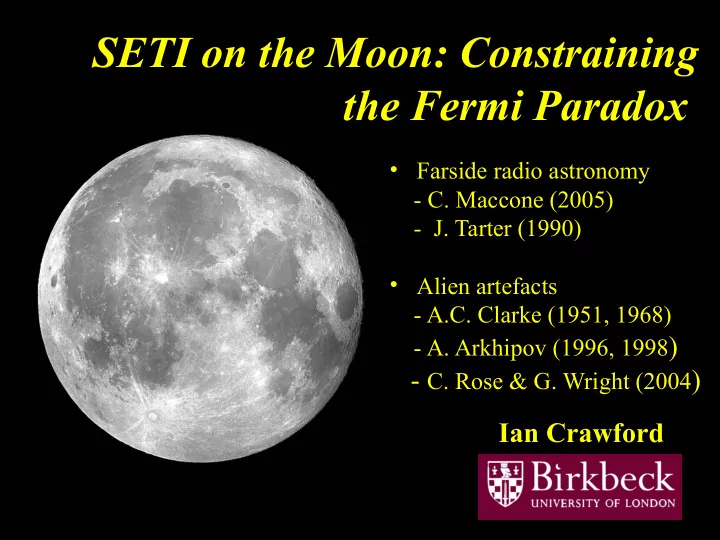

SETI on the Moon: Constraining the Fermi Paradox • Farside radio astronomy - C. Maccone (2005) - J. Tarter (1990) • Alien artefacts - A.C. Clarke (1951, 1968) - A. Arkhipov (1996, 1998 ) - C. Rose & G. Wright (2004 ) Ian Crawford
The Drake Equation: N ETI = R * × f p × n e × f l × f i × f c × L N ETI = { Rate of ETI formation} × L Optimistically, N ETI = L If L =1000 years, N ETI = 1000 and one star in a 10 8 presently harbours a technological civilisation. But this assumption also implies that a total of about 10 10 civilisations have existed over the age of the Galaxy.
Can the lunar geological record help?
…. “Our results suggest that carefully searching our own planetary backyard may be likely to reveal evidence of extraterrestrial civilisations as studying distant stars through telescopes….” Nature , 431, 47, (2004 ).
• Space-faring civilisations cannot avoid generating space debris ( A.V. Arkhipov ( JBIS , 51, 181, 1998). • Even without a deliberate programme of interstellar travel, much of this debris will be ejected into interstellar space. • Large particles will be grav- itationally ejected from parent planetary system (cf. Voyager ). Small (e.g. ≤ µm-sized) particles (e.g. exotic alloys from rocket motors) will be ejected by radiation. • The more space-faring civilisations there have been in the Galaxy the more interstellar space debris will exist…..
The distributive consequences of stellar evolution …… About 700 million ‘solar type’ (F5 to G2) stars will have already left the main sequence (Zuckerman, QJRAS , 26 , 56, 1985)…..
Debris will be swept up into dust clouds and concentrated in spiral arms, through which the Solar System passes. ( cf “Pollination of exoplanets by nebulae”, W.M. Napier, IJA, 6, 223, 2007).
How much debris might we expect? A back of the envelope calculation suggests that the No. of particles to have struck the Moon in the last 4 billion years is: N artifacts ≈ 10 -7 × F × L × N F = factor by which µm-sized debris generation exceeds present terrestrial space debris flux (6×10 18 /year) L = lifetime of debris producing civilisaton (years) N = Number of debris-producing civilisations L=1000 years and F =1: N artifacts ≈ 10 -4 × N L=1000 years and F =10 4 : N artifacts ≈ N (If N =10 10 → 260 per km 2 )
Requires careful searching in and below the regolith …
Recommend
More recommend